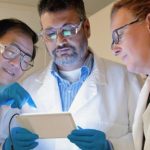
Researchers in India have developed an AI tool that can identify the median nerve in ultrasound videos and detect carpal tunnel syndrome (CTS).
CTS occurs when the median nerve, which runs from the forearm into the hand, is compressed at the carpal tunnel part of the wrist, resulting in numbness, tingling or pain.
The condition is one of the most common nerve-related disorders, specifically affecting individuals who perform repetitive hand movements, such as office staff who work with keyboards and assembly line workers.
Doctors currently rely on ultrasound to visualise the median nerve, and assess its size, shape and any potential abnormalities.
“But unlike X-rays and MRI scans, it’s hard to detect what’s going on in ultrasound images and videos,” said Karan R Gujarati, first author and former MTech student at the Department of Computational and Data Sciences (CDS), Indian Institute of Science (IISc).
“At the wrist, the nerve is quite visible, its boundaries are clear, but if you go down to the elbow region, there are many other structures, and the boundaries of the nerve are not clear.”
Tracking the median nerve is also important for treatments requiring doctors to administer local anaesthesia to the forearm or block the median nerve to provide pain relief.
To develop their tool, the researchers turned to a machine learning model based on transformer architecture, similar to the one powering ChatGPT.
The model was originally developed to simultaneously detect dozens of objects in YouTube videos.
The researchers stripped the model’s computationally expensive elements to speed it up, and cut down the number of objects it could track to just one – the median nerve, in this case.
The team collaborated with Lokesh Bathala, Lead Consultant Neurologist at Aster-CMI Hospital, to collect and annotate ultrasound videos from both healthy participants and people with CTS, to train the model.
After training, the model was able to segment the median nerve in individual frames of the ultrasound video.
Corresponding author, Phaneendra K Yalavarthy, a Professor at CDS, said: “Imagine a video of an autonomous car.
“If the car is moving on the road, you want to track the car.
“In the same way, we are able to track the nerve throughout the video.”
The model could also automatically measure the cross-sectional area of the nerve, which is used to diagnose CTS.
The measurement is performed manually by a sonographer.
Bathala said: “The tool automates this process. It measures the cross-sectional area in real time.”
It was able to report the cross-sectional area of the median nerve with more than 95 per cent accuracy at the wrist region, the researchers said.
Although many machine learning models have been developed to screen CT and MRI scans, very few have been developed for ultrasound videos, especially nerve ultrasound, Yalavarthy said.
Bathala said: “Initially, we trained the model on one nerve. Now we are going to extend it to all nerves in the upper and lower limbs.”
He added that it has already been deployed as a pilot test in the hospital.
“We have an ultrasound machine connected to an additional monitor where the model is running.
“I can look at the nerve, and at the same time, the software tool is also delineating the nerve. We can see its performance in real time.”
Bathala said that the next step would be to look for ultrasound machine manufacturers who can integrate this into their systems.
“This kind of tool can assist any doctor. It can reduce the inference time.
“But of course, the final diagnosis will need to be done by the physician.”
Image: Aster-CMI Hospital




